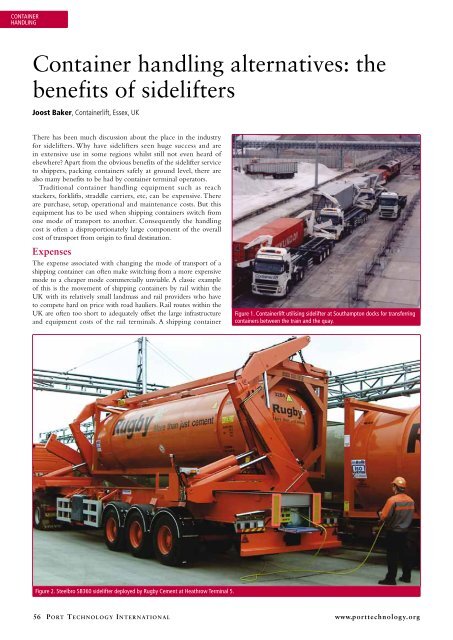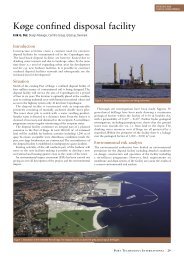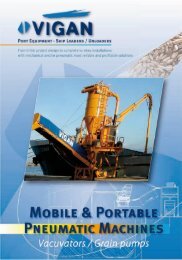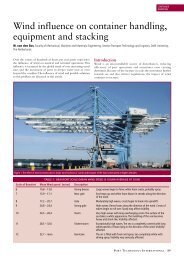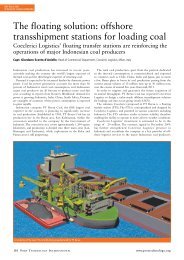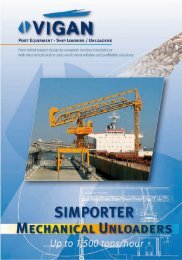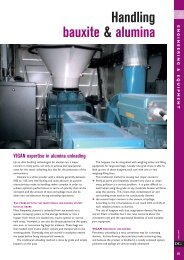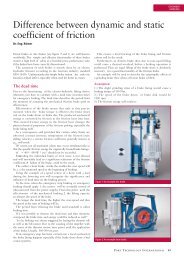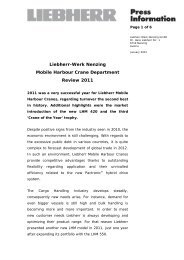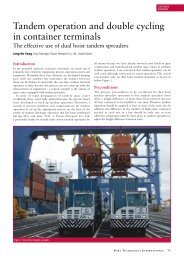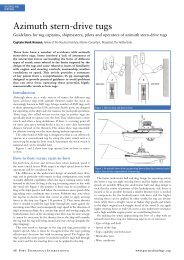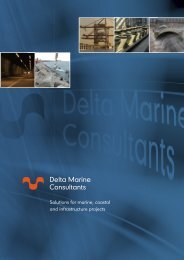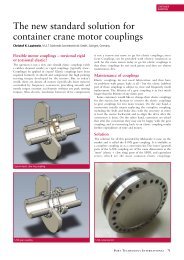Container handling alternatives: the benefits of sidelifters - Port ...
Container handling alternatives: the benefits of sidelifters - Port ...
Container handling alternatives: the benefits of sidelifters - Port ...
Create successful ePaper yourself
Turn your PDF publications into a flip-book with our unique Google optimized e-Paper software.
CONTAINERHANDLING<strong>Container</strong> <strong>handling</strong> <strong>alternatives</strong>: <strong>the</strong><strong>benefits</strong> <strong>of</strong> <strong>sidelifters</strong>Joost Baker, <strong>Container</strong>lift, Essex, UKThere has been much discussion about <strong>the</strong> place in <strong>the</strong> industryfor <strong>sidelifters</strong>. Why have <strong>sidelifters</strong> seen huge success and arein extensive use in some regions whilst still not even heard <strong>of</strong>elsewhere? Apart from <strong>the</strong> obvious <strong>benefits</strong> <strong>of</strong> <strong>the</strong> sidelifter serviceto shippers, packing containers safely at ground level, <strong>the</strong>re arealso many <strong>benefits</strong> to be had by container terminal operators.Traditional container <strong>handling</strong> equipment such as reachstackers, forklifts, straddle carriers, etc, can be expensive. Thereare purchase, setup, operational and maintenance costs. But thisequipment has to be used when shipping containers switch fromone mode <strong>of</strong> transport to ano<strong>the</strong>r. Consequently <strong>the</strong> <strong>handling</strong>cost is <strong>of</strong>ten a disproportionately large component <strong>of</strong> <strong>the</strong> overallcost <strong>of</strong> transport from origin to final destination.ExpensesThe expense associated with changing <strong>the</strong> mode <strong>of</strong> transport <strong>of</strong> ashipping container can <strong>of</strong>ten make switching from a more expensivemode to a cheaper mode commercially unviable. A classic example<strong>of</strong> this is <strong>the</strong> movement <strong>of</strong> shipping containers by rail within <strong>the</strong>UK with its relatively small landmass and rail providers who haveto compete hard on price with road hauliers. Rail routes within <strong>the</strong>UK are <strong>of</strong>ten too short to adequately <strong>of</strong>fset <strong>the</strong> large infrastructureand equipment costs <strong>of</strong> <strong>the</strong> rail terminals. A shipping containerFigure 1. <strong>Container</strong>lift utilising sidelifter at Southampton docks for transferringcontainers between <strong>the</strong> train and <strong>the</strong> quay.Figure 2. Steelbro SB360 sidelifter deployed by Rugby Cement at Heathrow Terminal 5.56 P o rt Technology Internat i o n a l www.porttechnology.org
CONTAINERHANDLINGFigure 3. Sidelifter carrying out its own lift on <strong>the</strong> quay.moved by rail still requires a road leg to its final delivery point,adding to <strong>the</strong> transport cost. If containers could be transferredbetween road and rail more economically and if containers could berailed closer to <strong>the</strong> final delivery site ra<strong>the</strong>r than to a large centrallylocated terminal, rail would be more competitive.The purchase price <strong>of</strong> a reach stacker, heavy forklift or straddlecarrier is <strong>of</strong>ten dwarfed by <strong>the</strong> huge cost <strong>of</strong> civil works this type<strong>of</strong> equipment requires. A large expanse <strong>of</strong> reinforced concrete isrequired to support <strong>the</strong> massive ground loadings exerted. Thereis also very little flexibility for redeployment <strong>of</strong> equipment. If<strong>the</strong>re is no train to service, for example, a huge amount <strong>of</strong> moneyin tied up in equipment and civil works that is essentially doingnothing and creating very little return.Sidelifters v reach stackersRugby Cement, now Cemex, considered all <strong>the</strong>se issues when <strong>the</strong>ydecided to deploy <strong>sidelifters</strong> ra<strong>the</strong>r than reach stacker equipment at<strong>the</strong> rail sidings for <strong>the</strong> Heathrow Terminal 5 project. Two SteelbroSB360 <strong>sidelifters</strong> were put into operation for lifting 30ft ISOveyorcontainer tanks between rail wagons and standard skeletal trailers.The ISOveyors each weighed up to 32 tonnes when loaded withPulverised Fly Ash (PFA). Minimal investment was needed for surfacepreparation, as no reinforced operating surface was required. Two<strong>sidelifters</strong> were not only cheaper to buy than one reacher stacker;two machines also gave service assurance, as Rugby Cement wouldincur large penalties if <strong>the</strong>re were a break in <strong>the</strong> supply <strong>of</strong> PFA. If<strong>the</strong>ir operation were relying on a single reach stacker, in <strong>the</strong> event<strong>of</strong> a breakdown, container <strong>handling</strong> capacity would go from 100 percent to 0 per cent. With two <strong>sidelifters</strong> in operation, a breakdownwould mean only 50 per cent <strong>handling</strong> capacity lost. As <strong>sidelifters</strong> arestandard road going trailers, a return to full <strong>handling</strong> capacity couldquickly be achieved by deploying a replacement sidelifter to site in amatter <strong>of</strong> hours. Not an option with a reach stacker.about <strong>the</strong> company<strong>Container</strong>lift are <strong>the</strong> UK’s leading provider <strong>of</strong> ground-based container <strong>handling</strong>services. Keeping containers on <strong>the</strong> ground is <strong>the</strong> cost-effective and safe solutionfor many transport and haulage situations. We have <strong>the</strong> products, experience andsolutions to change <strong>the</strong> way you think about container transport.Case studiesSidelifter equipment can provide savings and added flexibilityto a container depot, intermodal or port operations, and <strong>the</strong>reare numerous examples where this has happened. The port <strong>of</strong>Go<strong>the</strong>nburg in Sweden has setup a dedicated sidelifter deliveryarea. Hauliers arriving at <strong>the</strong> port with a sidelifter can lift onor lift <strong>of</strong>f <strong>the</strong>ir own shipping containers within <strong>the</strong> designatedarea without interfacing directly with <strong>the</strong> ports straddle carriers.This <strong>benefits</strong> <strong>the</strong> port with improved equipment utilisation andtempered peaks and troughs <strong>of</strong> container traffic. During quieterperiods <strong>the</strong> straddle carriers can continue delivery and collectingcontainers to <strong>the</strong> sidelifter area whe<strong>the</strong>r <strong>the</strong>re are vehicles <strong>the</strong>re ornot. The benefit to <strong>the</strong> haulier is a much faster vehicle turn aroundtime avoiding <strong>the</strong> normal queues and time spent sitting on <strong>the</strong>grid waiting to be serviced by a straddle carrier or reach stacker.Southampton <strong>Container</strong> Terminal (SCT) also ran a similaroperation in conjunction with EWS and <strong>Container</strong>lift wherebya sidelifter could carry out its own lifts on <strong>the</strong> quay. Seven<strong>Container</strong>lift <strong>sidelifters</strong> were operating 24 hours a day, six days aweek transferring containers between EWS trains and <strong>the</strong> quay.A sidelifter would lift an export container directly from <strong>the</strong> train,carry <strong>the</strong> container a kilometre to <strong>the</strong> quay where it would lift<strong>the</strong> container to <strong>the</strong> ground. In <strong>the</strong> same fashion, <strong>the</strong> sidelifterwould return to <strong>the</strong> train with an import container.The discussion about <strong>the</strong> place for <strong>sidelifters</strong> in <strong>the</strong> industryusually focuses on sidelifter versus reach stacker or sidelifterversus straddle carrier, and <strong>the</strong> conclusions are usually andpredictably in support <strong>of</strong> traditional equipment. There is,however, a growing number <strong>of</strong> successful sidelifter based terminaloperations. There are also good examples where <strong>the</strong> flexibility<strong>of</strong> <strong>sidelifters</strong> has been incorporated into established port andterminal operations with positive results for all. By simplydismissing <strong>sidelifters</strong> could we still be missing a trick?EnquiriesTel: +44 (0) 1371 879400Fax: +44 (0) 1371 879444Email: enquiries@containerlift.co.ukWeb: www.containerlift.co.ukP o rt Technology Internat i o n a l 57


